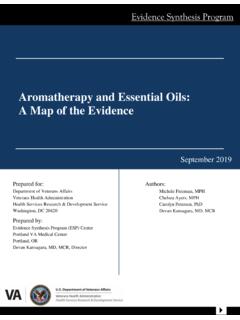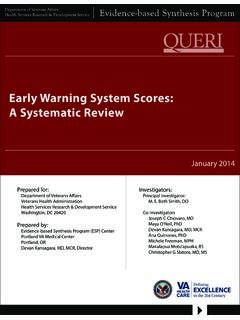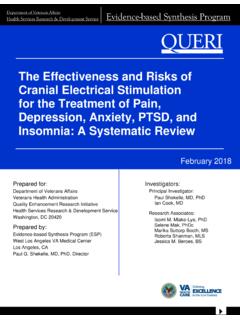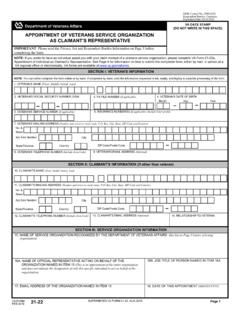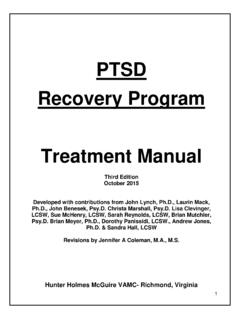Transcription of Care Assessment Need (CAN) Score and the Patient Care ...
1 Care Assessment Need (CAN) Score and the Patient Care Assessment System (PCAS): Tools for Care Management Stephan Fihn MD MPH Tami Box PhD Office of Informatics and Analytics Veterans Health Administration June 27, 2013 VA s Health Care Delivery Model Coordinated Care Personalized, Proactive and Patient -Driven Team Care Continuous Improvement Data-Driven, Evidence-Based Value Prevention / Population Health VETERANS HEALTH ADMINISTRATION Goal: Enhance Quality & Eliminate Unnecessary, Unplanned Care VETERANS HEALTH ADMINISTRATION Top 10 VHA Discharge Diagnoses 2008 Affective psychoses Heart Failure Chronic ischemic heart disease Respiratory symptoms/other chest sx Pneumonia Cardiac dysrhythmias Schizophrenic disorders Chronic bronchitis Alcohol dependence General symptoms (Maynard and Fihn, Internet Journal Epi 2010)
2 VETERANS HEALTH ADMINISTRATION 4 VETERANS HEALTH ADMINISTRATION Broad range of clinical programs designed improve care for veterans with complex chronic illness Home-based primary care Case-management Specialty clinics, , heart failure Telehealth Palliative care Knowledge of a Patient s risk of adverse event can help target services Providers can t accurately predict Veterans at highest risk of deterioration PACT RN Care Managers charged to coordinate care No systematic way to identify Veterans who might benefit most predictive analytics using data from EHR Modeling Strategy Patient characteristics Demographics age, priority level Coexisting conditions Deyo/Charlson Score , HCCs Vital signs Utilization inpatient and outpatient Pharmacy Lab values Outcomes occurring in subsequent yr.
3 Readmissions, deaths, either at 30, 60, 90 days & 1 yr Conjoint modeling admission and death using polytomous (multinomial) logistic regression VETERANS HEALTH ADMINISTRATION VETERANS HEALTH ADMINISTRATION Model Terms 1. Demographics Diabetes Recent Admission Bumetanide/ Torsemide Age ( 65) Liver disease BDOC (1-10 vs 0) Thiazides Sex Malnutrition No. providers (>3) CCB Marital status Dementia 4. Vital Signs Digoxin Svc . Conn. 50% Functional disease Sys & Dias BP Furosemide 2. Chronic Illness Metastatic Cancer Heart rate (>85) Insulin Deyo-Charlson Trauma Resp.
4 Rate ( 20) Metolazone HCCs Psych disease BMI (<25) Metformin MI/UA/CABG ptsd 5. Pharmacy Nitrate-long acting Valvular dis. Depression To t a l # refills (>0 ) Opioids Resp. failure 3. Utilization ACEI/ARB NSAIDS HTN Outpt visits(>4) Alpha-blocker Lipid lowering drugs Stroke PC visits (>1) Nebulized drugs P- par-gamma-agonists Renal Failure Cardiology visits Antiplatelet drugs K+ sparing diuretic COPD Pulmonary visits Anti-depressants Oral steroids Atrial fib. Mental health visits Antipsychotics Warfarin ASPVD ER visits (>1 lst yr) Benzodiazepine 6. Interactions Pneumonia Other visits (>3) Beta-blockers 18 interaction terms RRR or RRR (adm); RRR or RRR (death); RRR or RRR (both) VETERANS HEALTH ADMINISTRATION Care Assessment Need (CAN) Score Reflects estimated probability of admission or death within a specified time period (90 days or 1 year) Expressed as a percentile, ranging from 0 (lowest risk) to 99 (highest risk) Indicates how a given Veteran compares with other individuals in terms of likelihood of hospitalization or death VETERANS HEALTH ADMINISTRATION 9 Predicted and Observed Likelihood of Death/Admission 4,505,501 primary care patients C= C= C= C= C= C= Wang, et al.
5 Med Care. 2013;51:368-73. VETERANS HEALTH ADMINISTRATION 10 95th %ile 39% 96th %ile 42% 97th %ile -- 49% 98th %ile -- 57% 99th %ile -- 72% Patients in highest percentile of risk have 62% probability of admission, 30% probability of death, and 72% probability of either event 11 Comparison with other models expected risk of death or unplanned readmission within 30d LACE model tested on 1M randomly selected pts discharged from Ontario observed risk hospitals 2004-08 (C statistic = ). Readmission model for 10,946 pts disch home from general medicine svcs at 6 AMCs. Hason, et al. JGIM Dec VE 2009 (TERANS HeEpub ALTH aheADMad INISTRof A TIprOiN nt ) Walraven et al CMAJ March 2010 (epub ahead of print) Use of High Level Analytic Data for Population Management and Resource Planning Dynamic Geospatial Mapping 1-yr likelihood of admission - - - - - 1-yr likelihood of admission or death - - - - - 12 VETERANS HEALTH ADMINISTRATION How to Access the CAN Score Report Risk Data Updated Weekly About 1000 users monthly\ Also reports can be developed using from Regional Data Warehouses VETERANS HEALTH ADMINISTRATION Marketing the CAN Score Available to all PCPs from EHR in Dec 2011 soft roll-out Active roll-out in two VISNs VISN 4 PC Collaborative VISN 17 Live Broadcast (champion model)
6 Broadcasts with live Q&A: primary care, nursing, VeHU Feedback to date uniformly positive (some concerns about data overload) VETERANS HEALTH ADMINISTRATION 16 Marketing the CAN Score Encouraging Care Coordination all participants in the delivery of health services work cooperatively facilitating access to care right care in the right place at the right time shared responsibility Encouraging Care Management Linking patients with needed services, resources, and opportunities Discouraging misuse of the Score The Score is not a performance measure to try to improve A high Score does not indicate a pt is not receiving high quality of care A low Score is not an indication to ignore a pt VETERANS HEALTH ADMINISTRATION Can CAN scores help?
7 After adjusting for age, sex, comorbidity, and mental health diagnoses, patients with CAN scores in the highest 10% who saw their assigned PCP for >60% of visits, were 10% less likely to die or be hospitalized than similar risk patients who did not see their PCP during the year before PACT implementation. Similar, but less pronounced association for high risk patients who saw their assigned PCP up to 60% of the time. VETERANS HEALTH ADMINISTRATION 18 High Number of Health Care Providers per Patient by CAN Score VETERANS HEALTH ADMINISTRATION 19 High Number of Different Drugs per Patient by CAN Score VETERANS HEALTH ADMINISTRATION Mental Health Diagnoses according to CAN Score VETERANS HEALTH ADMINISTRATION 21 Bed Days - Per Patient , Average VETERANS HEALTH ADMINISTRATION Few Patients with High Scores Referred to Coordination Programs.
8 Telehealth, HBPC, Palliative Care, and Hospice VETERANS HEALTH ADMINISTRATION Palliative Care Score 95 --1,353 of 241,917 total patients ( ) Hospice Score 95 -- 569 of 241,917 total patients ( ) Total Patientss and Percentage with CAN Score 95 by Geographic Area VETERANS HEALTH ADMINISTRATION VETERANS HEALTH A How might a care manager or provider use the tool? Scan list of pts weekly to identify those who may be at high risk Call high risk patients to check in: are questions answered? are medications taken as prescribed? Confirm that high risk pts have visits coming up soon Ensure that high risk patients are on appropriate medical therapy Review resources already in use, such as telehealth DMoIr sNISTRpAeTIcOialtN y care Feedback 6-19-13 Attached is the PP created for local executive leadership, to gain their buy-in and support, which we have fully received.
9 I am beginning to educate frontline staff on this structured framework so they can better understand the importance of risk stratification. This education allows them to begin connecting the dots of the different settings, how they impact the continuum of care, and how we can better serve our Veterans together, especially those suffering from chronic diseases. So far I have received positive feedback from frontline staff and leadership. Our Home Telehealth program has begun utilizing the CANS to pull their Veterans into the program, rather than waiting for Veterans to be pushed into the program. The PACT teams utilize the CANS for specifically for Patient selection for shared medical appointments. Several PACT teams also cross-reference the CANS with the DataMart database for Patient selection of chronic disease management protocols. VETERANS HEALTH ADMINISTRATION 26.
10 Continued We plan to implement the CANS in Specialty Clinic and Case Management over the next year. We are currently developing and expanding these two areas to center our care around Veterans actively suffering from chronic diseases by establishing a partnership to assist and guide Veterans with self-management. Case Managers are currently developing inclusion and exclusion criteria for their newly developed case management programs, and will include the CANS as a criteria point to consider when consulted. Specialty Clinic will utilize CANS for Patient selection in shared medical appointments and chronic disease management protocol, similar to PA C T.. The CANS is the missing link, as we previously had no method to stratify the Patient panel, to identify those high-utilizers, high-cost Veterans. Now with the CANS we can better serve our Veterans suffering from chronic diseases in a more efficient, ideal method.
